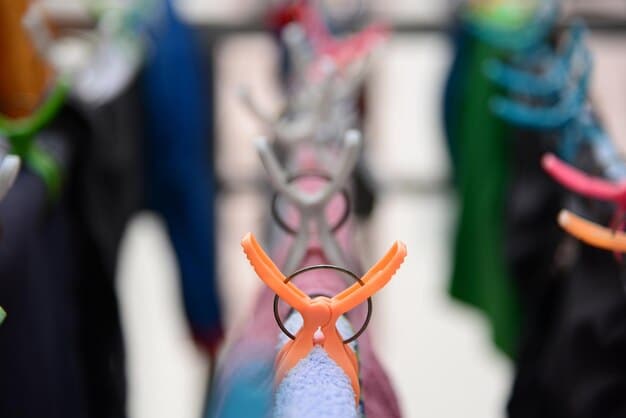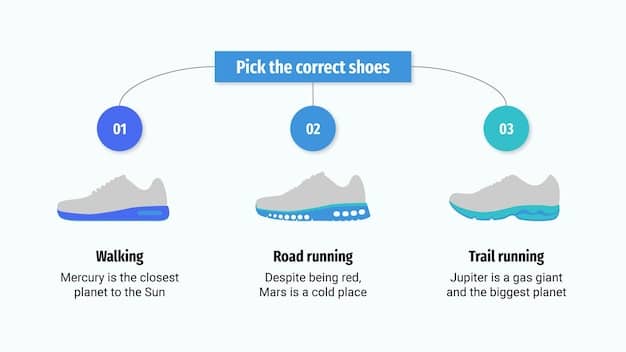Running Shoe Rotation: Boost Shoe Life by 30%

Advertisements
Running shoe rotation involves using multiple pairs of running shoes and alternating them regularly, which can extend the life of each pair by up to 30% by allowing the midsole foam to recover fully between runs while also providing varied support and cushioning to reduce injury risk.
Are you looking to get more out of your running shoes and avoid common running injuries? Implementing a smart running shoe rotation strategy can extend the life of your shoes by approximately 30%—saving you money and keeping you comfortable on every run.
Advertisements
Why Running Shoe Rotation Matters
Running shoes take a beating with each stride. The constant impact compresses the midsole, which is responsible for cushioning and support. Rotating your shoes gives the foam time to recover, enhancing its performance and longevity.
But it’s not just about shoe lifespan. Varying the shoes you wear can also benefit your body. Different shoes offer different levels of support, cushioning, and flexibility, which can help distribute the impact forces and reduce the risk of overuse injuries.
Advertisements
Extending Shoe Lifespan
The primary benefit of shoe rotation is giving the midsole foam time to decompress and recover. When foam is continuously compressed, it loses its resilience more quickly.
Reducing Injury Risk
Using different shoes can also help reduce the risk of injuries. By varying the stress on your feet and legs, you prevent repetitive stress injuries.
- Allowing midsole foam to fully recover, regaining cushioning and support.
- Reducing repetitive stress on specific areas of your feet and legs.
- Promoting balanced muscle development by using different shoe types.

Implementing a rotation system can significantly improve your running experience by maintaining shoe integrity and promoting overall well-being. By investing in multiple pairs and strategically rotating them, you’re ensuring each run is supported by optimally performing footwear.
Understanding Your Running Shoe Needs
Before diving into a rotation, understanding your running style, foot type, and the types of runs you do is essential. This will guide you in selecting the right shoes for your rotation.
It’s important to analyze your specific requirements to construct a rotation that addresses your unique needs. This tailored approach ensures maximum benefits, both in terms of shoe longevity and injury prevention.
Identifying Your Foot Type and Running Style
Determine whether you have neutral pronation, overpronation, or underpronation. Also, consider whether you are a heel striker or a midfoot striker.
Considering Different Types of Runs
Think about the types of runs you typically do, such as easy runs, tempo runs, and long runs. Each type might benefit from a different shoe.
- Neutral shoes: Ideal for runners with a neutral gait and medium arches.
- Stability shoes: Best for overpronators who need extra support.
- Cushioned shoes: Perfect for long runs when comfort is paramount.
By carefully assessing these elements and selecting the right shoes, you’ll create a rotation that supports your performance and minimizes the chances of injury.
Building Your Running Shoe Rotation
Now that you know your needs, it’s time to build your rotation. Start with at least two pairs of running shoes, each serving a different purpose. As you become more experienced, you can expand your collection.
The goal is to have a diverse set of shoes that work together harmoniously to meet all your running demands. By strategically selecting shoes that complement each other, you’ll achieve a balanced and effective system.

Essential Shoe Types for Rotation
Consider having a daily trainer, a tempo shoe, and a long-run shoe. Each design caters to different running styles and purposes, resulting in a thorough and complete rotation.
Matching Shoes to Run Types
Assign each shoe to specific runs. Use the daily trainer for easy runs, the tempo shoe for faster workouts, and the long-run shoe for distance.
- Daily trainers: For everyday runs – balanced cushioning and support.
- Tempo shoes: Lighter and more responsive for speed workouts.
- Long-run shoes: Maximum cushioning and comfort for long distances.
This systematic rotation boosts shoe life and enhances running experience, reducing injury risk and improving performance.
Tracking Mileage and Shoe Lifespan
To get the most out of your rotation, you need to track the mileage on each pair of shoes. Over time, even rotated shoes will wear out. Knowing when to replace them is critical for maintaining performance and safety.
It’s not just about logging kilometers; it’s about monitoring how each pair performs during different types of activities. Observing performance changes helps identify when it’s time for a change.
Using Apps and Tools
Utilize apps like Strava, Runkeeper, or Garmin Connect to track the distance you run in each pair of shoes.
Knowing When to Replace Your Shoes
Replace your shoes every 300-500 miles, depending on your weight, running style, and the type of shoe. Look for signs of wear, such as reduced cushioning or visible damage to the outsole.
- Record distance using running apps to monitor shoe mileage accurately.
- Note changes in shoe feel – loss of cushioning or support indicates wear.
- Inspect shoe condition for outsole wear, midsole compression, or upper damage.
Regular tracking and timely replacement of shoes ensures ongoing support, protection, and optimum performance, minimizing the risk of strain or injury.
Maintaining Your Running Shoes
Proper care can extend the life of your running shoes. Cleaning them regularly and storing them correctly can prevent premature wear and tear.
Consistent maintenance not only extends shoe life but also protects your investment. Establishing a maintenance regimen keeps shoes at their supportive best.
Cleaning Your Shoes
Clean your shoes after muddy or wet runs. Use a soft brush and mild soap to remove dirt and debris.
Storing Your Shoes Properly
Store your shoes in a cool, dry place away from direct sunlight. Use shoe trees to help maintain their shape and wick away moisture.
- Wash them gently after muddy or wet runs using a soft brush and mild soap.
- Store them in good conditions so they stay in good condition.
- Air dry them at room temperature, away from direct sunlight or heat.
These quick and simple maintenance habits can significantly increase your shoes’s lives, ensuring that they stay in great condition for as long as possible.
Advanced Rotation Strategies
Once you’re comfortable with the basics, you can explore more advanced rotation strategies. This might include adding shoes with specific features or rotating shoes based on different terrains.
Advanced strategies cater to the needs of seasoned runners or those with specific requirements. Fine-tuning your shoe choices can offer superior comfort and performance.
Considering Shoes with Specific Features
Experiment with shoes that have different heel-to-toe drops, levels of support, or cushioning types. This allows you to fine-tune your rotation to meet your specific needs.
Rotating Shoes Based on Terrain
If you run on both roads and trails, consider having separate shoes for each terrain. Trail shoes offer better traction and protection on uneven surfaces.
- Test shoes with varying heel-to-toe drops to find what best suits your biomechanics.
- Explore different cushioning technologies for tailored comfort and responsiveness.
- Separate road and trail shoes for maximum grip, protection, and performance on varying surfaces.
Customizing these techniques ensures you receive the best performance advantages when running, providing optimal performance, support, and injury prevention regardless of activity.
| Key Point | Brief Description |
|---|---|
| 👟 Shoe Rotation | Alternate different pairs of running shoes. |
| ⏱️ Recovery Time | Allow midsole foam to recover between runs. |
| 📊 Track Mileage | Monitor mileage to know when to replace shoes. |
| 🛡️ Prevent Injuries | Reduce repetitive stress by varying shoe type. |
Frequently Asked Questions
▼
Starting with two pairs is a good idea. As you become more experienced, you might want to add a third pair to cover different types of workouts, such as tempo runs or trail runs.
▼
Yes, but it’s generally better to rotate shoes with different characteristics. This ensures you are using a variety of support and cushioning options, reducing repetitive stress on your body.
▼
Ideally, switch after each run. This gives each pair ample time to recover. If you run daily, alternate between pairs each day. If you run less frequently, ensure each pair rests for at least 24 hours before its next use.
▼
Signs include reduced cushioning, visible wear on the outsole, and discomfort during or after your runs. Also, if you’ve exceeded the recommended mileage (300-500 miles), it’s likely time for a new pair.
▼
No, it’s beneficial for runners of all levels. Even if you only run a few times a week, rotating shoes helps extend their lifespan and can reduce your risk of injuries, making it a worthwhile practice.
Conclusion
Implementing a running shoe rotation strategy is a game-changer for extending the life of your shoes and minimizing injury risks. By understanding your needs, building a diverse rotation, and maintaining your footwear, you can enjoy more comfortable and injury-free runs for years to come.